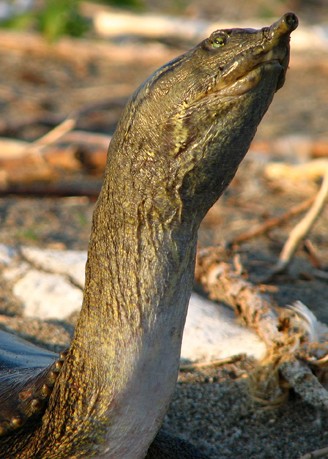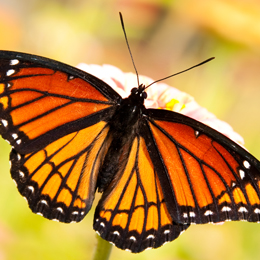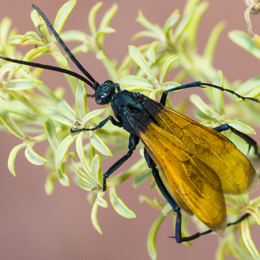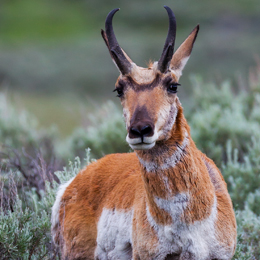Description
It was in 1827 that Charles Alexandre Lesueur first described this spectacular species of turtles. Since then, spiny softshell turtles have been re-described multiple times. This has led to some confusion in regards to the taxonomy of this species.
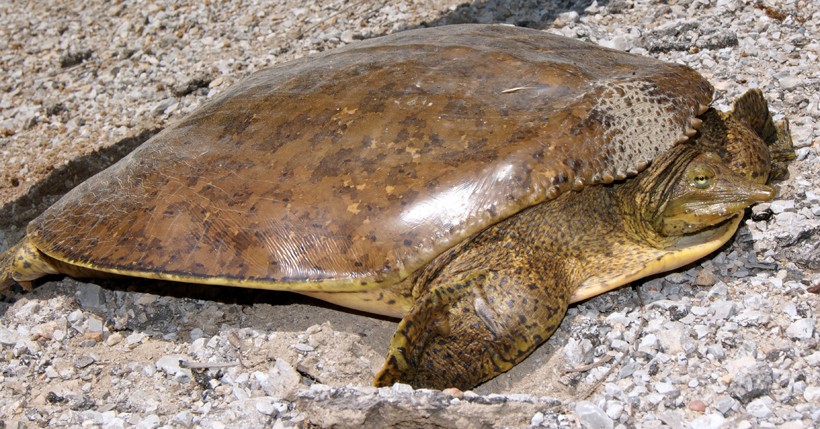
Spiny softshell turtles possess a rubber-like, flat and round upper shell.
?
Image credits: Matt Jeppson/Shutterstock
Spiny softshell turtles have multiple synonyms such as Amyda spinifera, Aspidonectes asper, Apalone hudsonica, Platypeltis agassizii, Trionyx ater, Trionyx spinifer, Aspidonectes emoryi and Trionyx spiniferus. These beautiful creatures can grow up to very large turtles whereby female spiny softshell turtles show a larger size than their male counterparts. Females can be anywhere between 7 and 19 in (17 and 48 cm) long, whereas males measure 5 to 10 in (12 to 25 cm) long. The turtles weigh up to 12 kg (26 lbs). Males maintain the same color from birth to adulthood whereas females become darker upon age. Females also develop a grayish mottling on the upper shell (carapaces). Male spiny softshell turtles possess a more rough upper shell as well as a longer and thicker tail than their counterparts.
Under favorable conditions, spiny softshell turtles can live up to 50 years of age. The turtles use their strong vision to locate their preys and are also known for their tactile communication.
Subspecies
There are six known subspecies of spiny softshell turtles, having distinct markings to differentiate one from the other. The markings are typically on the upper shell, feet and on both sides of the head. These markings are more prominent in the hatchlings and fade away upon age. It is difficult to differentiate the adult females of the six subspecies based on their appearance only. The major feature used to determine the different subspecies is their respective geographical locations.- Northern- or Eastern- Spiny Softshell Turtle (Apalone spinifera spinifera)
The Northern Spiny Softshell turtle, also known as the Eastern spiny softshell turtle, is the most popular subspecies of spiny softshell turtles. They are natives of the Eastern-Central United States and found in New York, West Virginia, North Carolina, Pennsylvania, Virginia, Ohio, Illinois, Indiana, Tennessee, Kentucky, Alabama, Iowa, Arkansas, Missouri, parts of Mississippi and parts of Wisconsin. The Northern spiny softshell turtle is the only freshwater turtle with a leathery carapace that appear in Canada (Quebec and Ontario). Their large black eye-like spots distinguish them from the rest of the subspecies. Another striking feature, what is specific to eastern spiny softshell turtles, is their single thick black line around the rim of the upper shells. The Alpalone spinifera hartwegi (western spiny softshell turtle), once recognized as another subspecies, is now considered a synonym of the A. s. spinifera, due to the limited morphological differences. They are recognizable by the much smaller black spots on the upper shell.
- Guadalupe Spiny Softshell Turtle (Apalone spinifera guadalupensis)
Guadalupe spiny softshell turtles live in a small region in South Texas. These subspecies can be quite large and contain white tubercles on their upper shells. These white tubercles possess a few black dots. The Guadalupe spiny softshell turtle lacks nasal septal ridges that are present in other subspecies.
- Texas Spiny Softshell Turtle (Apalone spinifera emoryi)
Texas spiny softshell turtles are found in Texas, Arizona and New Mexico. They also live in waters of some parts of California, Utah and Nevada. The upper shell of these subspecies is surrounded by pale rims. These rims are wide on the back and narrow on the sides. Black margins and stripes of the eyes are connected by a curved line and pale blotches can be found behind the eyes.
- Pallid Spiny Softshell Turtle (Apalone spinifera pallid)
This subspecies is found in Louisiana and certain parts of Texas, Arkansas and Oklahoma. Pallid spiny softshell turtles have white tubercles on the back till halfway the upper shell. The tubercles shrink in size towards the end and eventually fade away. The tubercles on pallid spiny softshell turtles do not have black dots.
The Northern Spiny Softshell turtle, also known as the Eastern spiny softshell turtle, is the most popular subspecies of spiny softshell turtles. They are natives of the Eastern-Central United States and found in New York, West Virginia, North Carolina, Pennsylvania, Virginia, Ohio, Illinois, Indiana, Tennessee, Kentucky, Alabama, Iowa, Arkansas, Missouri, parts of Mississippi and parts of Wisconsin. The Northern spiny softshell turtle is the only freshwater turtle with a leathery carapace that appear in Canada (Quebec and Ontario). Their large black eye-like spots distinguish them from the rest of the subspecies. Another striking feature, what is specific to eastern spiny softshell turtles, is their single thick black line around the rim of the upper shells. The Alpalone spinifera hartwegi (western spiny softshell turtle), once recognized as another subspecies, is now considered a synonym of the A. s. spinifera, due to the limited morphological differences. They are recognizable by the much smaller black spots on the upper shell.
Guadalupe spiny softshell turtles live in a small region in South Texas. These subspecies can be quite large and contain white tubercles on their upper shells. These white tubercles possess a few black dots. The Guadalupe spiny softshell turtle lacks nasal septal ridges that are present in other subspecies.
Texas spiny softshell turtles are found in Texas, Arizona and New Mexico. They also live in waters of some parts of California, Utah and Nevada. The upper shell of these subspecies is surrounded by pale rims. These rims are wide on the back and narrow on the sides. Black margins and stripes of the eyes are connected by a curved line and pale blotches can be found behind the eyes.
This subspecies is found in Louisiana and certain parts of Texas, Arkansas and Oklahoma. Pallid spiny softshell turtles have white tubercles on the back till halfway the upper shell. The tubercles shrink in size towards the end and eventually fade away. The tubercles on pallid spiny softshell turtles do not have black dots.
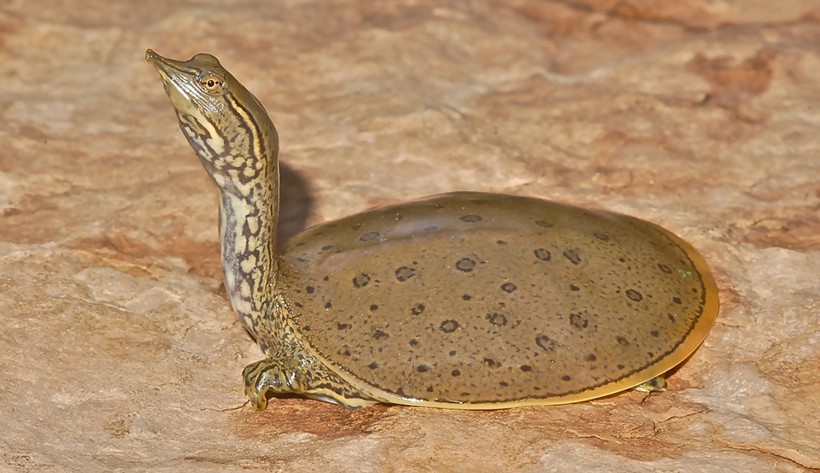
Gulf Coast Spiny Softshell Turtle
?
Image credits: James Harding/BY-SA 3.0, cropped image
- Gulf Coast Spiny Softshell Turtle (Apalone spinifera aspera)
The states of Mississippi, Georgia, Alabama, South Carolina and parts of Louisiana, Florida and North Carolina are homes to the Gulf Coast spiny softshell turtle. By these turtles, the lateral stripes of the head meet at the posterior of the head. They have two dark lines towards the rear of the upper shells as compared to one line of other spiny softshell turtles.
- Black Spiny Softshell Turtle (Apalone spinifera ater)
These brownish-black or dark gray subspecies are restricted to Mexico. They have gritty or smooth upper shells and the posterior of the upper shells are wrinkled. There are no tubercles on the rims. The bottom shells (plastrons) don’t contain any black spot.
The states of Mississippi, Georgia, Alabama, South Carolina and parts of Louisiana, Florida and North Carolina are homes to the Gulf Coast spiny softshell turtle. By these turtles, the lateral stripes of the head meet at the posterior of the head. They have two dark lines towards the rear of the upper shells as compared to one line of other spiny softshell turtles.
These brownish-black or dark gray subspecies are restricted to Mexico. They have gritty or smooth upper shells and the posterior of the upper shells are wrinkled. There are no tubercles on the rims. The bottom shells (plastrons) don’t contain any black spot.
Spiny Softshell Turtle Vs. Smooth Softshell Turtle
Smooth- and spiny softshell turtles are both freshwater turtles with soft shells. In spite of being related, there are a few differences between the two species. As the name suggests, smooth softshell turtles (Apalone mutica mutica) have smooth upper shells whereas the upper shells of spiny softshell turtles are rough with bumps or spines. The lateral nasal projections that are found in spiny softshells are absent in smooth softshells. Moreover, the white eye stripes of smooth softshell turtles are more distinct than that of spiny softshells. Unlike the spiny softshells, the white throat and chin of smooth softshells do not have black spots. As far as the behavior concerns, spiny softshells are more aggressive than smooth softshells.
Anatomy and Characteristics
Spiny softshell turtles possess a rubber-like, flat and round upper shell. There are small spines lined up on the upper shell. Unlike other turtles, the shell of spiny softshell turtles doesn't have scutes. The shell shows typically an olive or tan color and the upper shell has black spots with a dark lining circle around the edges. In some subspecies, two dark lines or some white spots may appear towards the end of the tail.
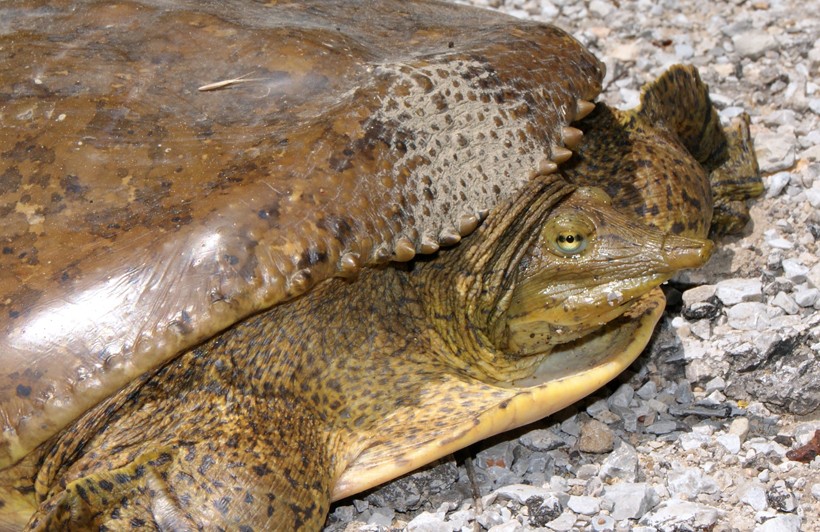
Spiny softshell turtles have long, tapered pinocchio-noses that contain ridges.
?
Image credits: Matt Jeppson/Shutterstock
Spiny softshell turtles have long, tapered noses that contain ridges. Their noses point up at the end. These striking noses make these turtles look like Pinocchio. The webbed feet with claws assist spiny softshell turtles during swimming. These freshwater turtles smell either through the skin or noses. The bones are visible from the off-white or yellow bottom shells. The North American turtles have fleshy lips with sharp and hard jaws.
The most distinct feature of spiny softshell turtles is the presence of small bumps on both sides of the nose, known as the nasal septum lateral ridge. This feature distinguishes them from their close relatives, the smooth softshell turtles. The long, tubular snouts allow these reptiles to breathe in water without exposing their bodies to any predator.
Habitat
Spiny softshell turtles prefer freshwater habitats such as rivers, marshes, farm ponds, lakes and bays of the Great Lakes. Open habitats with little vegetation and a muddy bottom are favored by these turtles. For basking and nesting, they need to raise sandy areas that are nearby water.
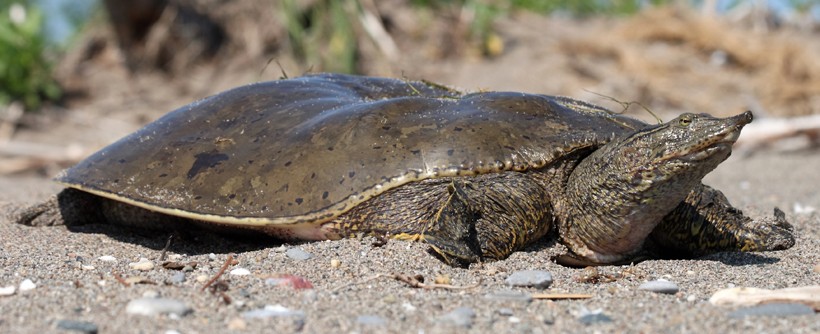
For basking and nesting, spiny softshell turtles need sandy areas that are nearby water.
?
Image credits: Ryan M. Bolton/Shutterstock
Apalone spinifera typically occupy a wide range in North America as mentioned above. In Canada, spiny softshell turtles thrive in Quebec and Ontario. The states of Chihuahua, Nuevo Leon, Coalhulia and Tamaulipas in Mexico are also homes for these turtles.
Prey and Predators
As carnivores, spiny softshell turtles eat fishes, shrimps, crickets, worms, crayfish and pink mice. Both the ways of active foraging and sit-and-wait ambush are used to secure the food. Using the active strategy, they typically search along the lake-bedding, under objects and within vegetation.
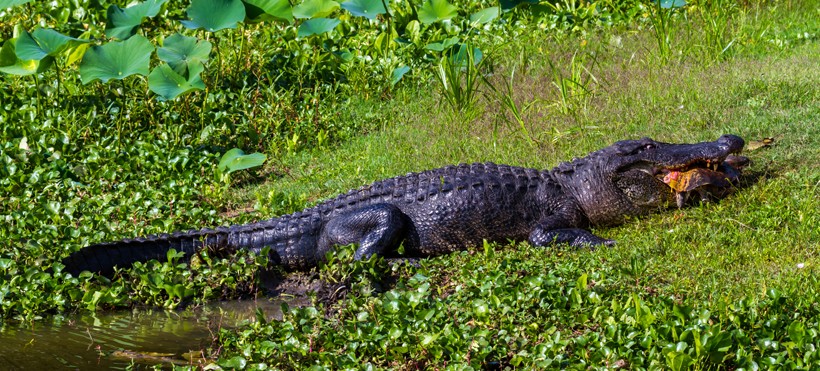
Spiny softshell turtle eaten by american alligator, Brazos Bend Park, Texas
?
Image credits: Richard A McMillin/Shutterstock
The nests of the spiny softshell turtles are raided by skunks, raccoons and foxes. These predators often destroy the nests and feast on the young turtles. The juveniles also face a threat from large fish, crows, alligators, bald eagles and water snakes. Adult spiny softshell turtles have few natural predators and killed by humans and American alligators. Being attacked, turtles snap at attackers resulting in painful bites. They quickly hide under sand or mud when they sense any threat.
Reproduction and Life Cycle
Female and male spiny softshell turtles reach sexual maturity between 8 and 10 years of age. In general, breeding occurs once a year. However, there are known cases where the female mate multiple times in a year. The mating typically takes place deep in the water, between mid to late spring.
Courtship involves nudging of the adult female's head by the male. This happens while swimming. If the female is willing to mate with the specific male that is courting, the male will swim on top of the female. Unlike other turtles, male spiny softshell turtles do not clasp female softshell turtles with their claws.
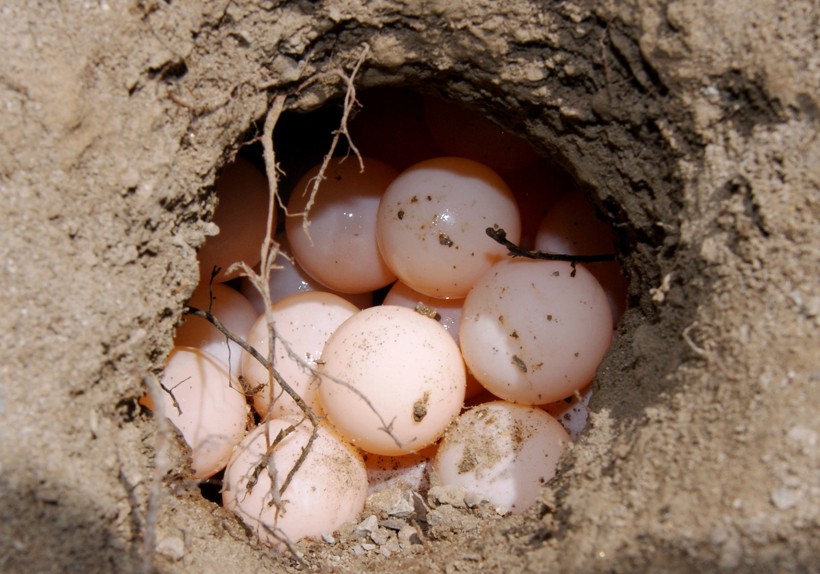
Spiny softshell turtle nest
?
Image credits: Matt Jeppson/Shutterstock
Females dig a nest close to water in sunny, open areas. The clutches are laid along gravel banks or sunny sandbars. Around 10 to 30 eggs are laid that hatch between August and September. After laying the eggs the female turtle leaves the nest. No parental care is further involved, all required nutrients to develop the hatchlings are stored within the egg. The eggs are around 29 mm in diameter and have hard shells to prevent them from drying out. Although the normal incubation period is between 2 and 3 months, sometimes the clutches incubate the entire winter and get hatched during the spring.
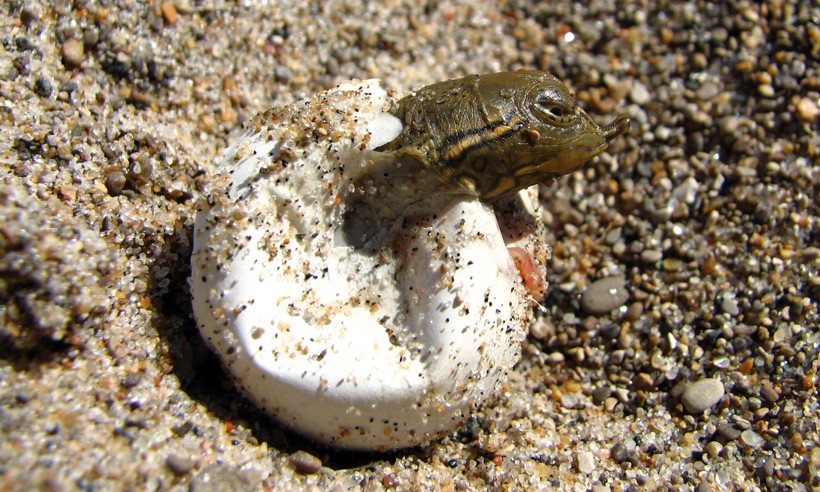
Spiny softshell turtle hatchling
?
Image credits: Ryan M. Bolton/Shutterstock
The sex of the turtles is not determined by the temperature during the incubation of the eggs but is determined genetically. Both eggs and newborn hatchlings are heavily preyed by predators such as foxes and raccoons. They are also vulnerable to fly maggot infestations.
Behavior
As being diurnal animals, these turtles are active during daytime. Spiny softshell turtles are heavily aquatic and remain in water most part of their life. Normally they leave the water environment only for laying down their eggs or sun basking on river banks or logs. Solitary by nature, spiny softshell turtles like to be alone. When disturbed, they quickly retreat to the water or hide in the sand or mud with only their heads visible.
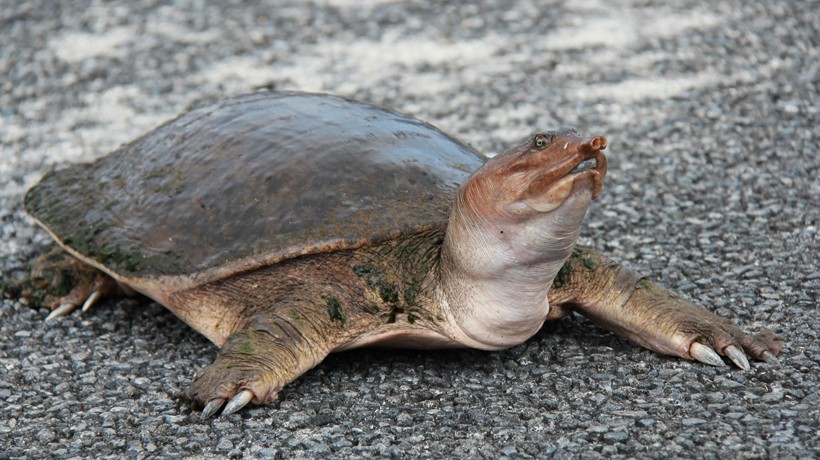
Lacking teeth, turtles may eat small rocks that help to pulverize the food in their stomach
?
Image credits: Brian Lasenby/Shutterstock
The months between October and April are spent underwater. They bury themselves in sand or mud of river/lake beddings and stay in a state of dormancy. Thanks to their remarkable skin, they are able to take oxygen from water. This ability to breathe underwater for long periods of time help them to survive during their period of hibernation.
The sandy or muddy beddings help the spiny softshell turtle also to ambush for unsuspecting prey. Sight, chemical signals, touch and vibrations are used to monitor their surroundings and detect any prey.
Population and Conservation Status
The exact population size of spiny softshell turtles is unknown. One thing is sure; they are quite common and widespread. The species as a whole is not threatened and is classified as least concern species. However, some subspecies may be threatened.
The major risks spiny softshell turtles face are a collision with boats, pollution, infrastructure development, fishermen and water diversion. Extensive habitat loss caused by constructions disturbs the sites used for nesting, basking, feeding and hibernation.
Besides human activities, predators such as raccoons and foxes are also potential threats for these turtles. They destroy the nests and prey upon the young spiny softshell turtles thereby decreasing their population.
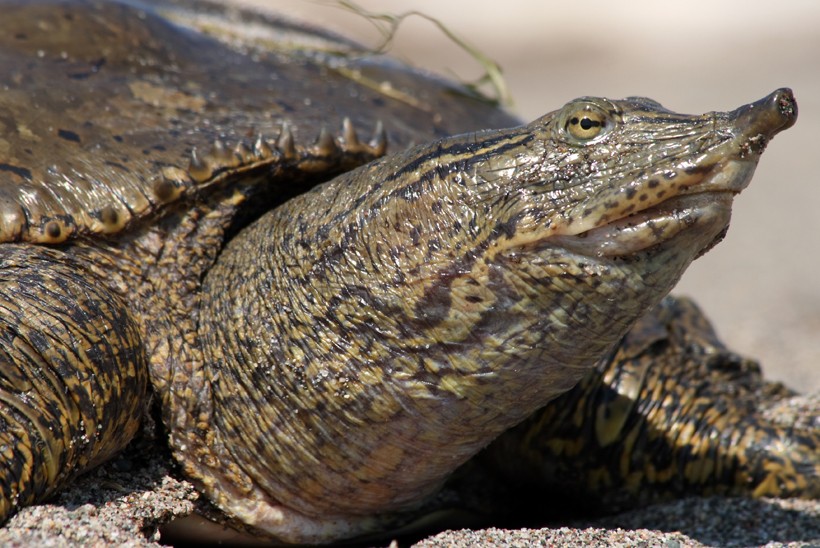
The species as a whole is not threatened and is classified as least concern species.
?
Image credits: Ryan M. Bolton/Shutterstock
A number of conservation measures are currently being carried out to protect these beautiful species. Protection of the nesting sites, raising awareness about these stunning reptiles, developing their habitats and trapping predators are some of the methods that will enhance spiny softshell turtle conservation efforts.
Evolutionary History
The evolution of turtles has been an enigma. Some studies suggest that turtles might be related to the Archosauria, the group consisting of crocodilians and birds. According to the predictions, turtles might have split from this group around 250 million years ago.
Funfacts
- Spiny softshell turtles are the only softshell turtles found in Canada.
- Although they look harmless, they can get very aggressive and bite.
- Spiny softshell turtles remain underwater from October - April. They are able to take oxygen from the water through their skin.
